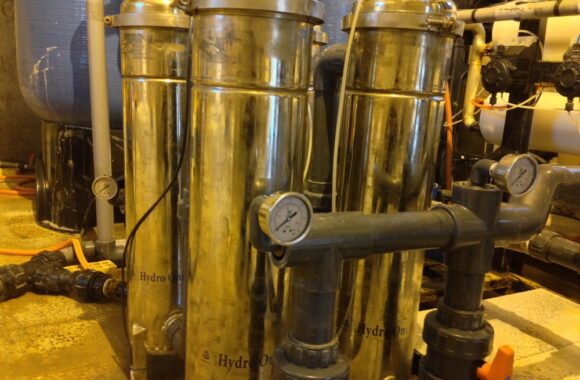Microfiltration (MF)
Microfiltration (MF)
Microfiltration (MF) is a filtration process commonly carried out using cartridge filters. The cartridge filters, or micron filters, are characterized by a cylindrical housing where the filters are placed. The replaceable components of the filter are called cartridges. The cartridges are also cylindrical, allowing them to easily fit inside the housing. The length and diameter of the cartridges are standardized for easy insertion into the housing. Typically, when pressure is applied, the liquid passes through the filter, while suspended particles are trapped on the surface of the filter, allowing filtered water to pass through. MF filters are used when the percentage of contaminants is less than 0.01% by weight or less than 100 ppm. These filters are capable of removing particles ranging from 0.5 micrometers to 0.1 micrometers or even smaller, depending on the desired output water quality and the filter material. The nominal efficiency of MF systems is generally high, ranging from 80% to 90%, and their absolute efficiency has been reported to be between 98% and 99.99% in various references.
Microfiltration (MF) is a filtration process commonly carried out using cartridge filters. The cartridge filters, or micron filters, are characterized by a cylindrical housing where the filters are placed. The replaceable components of the filter are called cartridges. The cartridges are also cylindrical, allowing them to easily fit inside the housing. The length and diameter of the cartridges are standardized for easy insertion into the housing.
Typically, when pressure is applied, the liquid passes through the filter, while suspended particles are trapped on the surface of the filter, allowing filtered water to pass through. MF filters are used when the percentage of contaminants is less than 0.01% by weight or less than 100 ppm. These filters are capable of removing particles ranging from 0.5 micrometers to 0.1 micrometers or even smaller, depending on the desired output water quality and the filter material.
The nominal efficiency of MF systems is generally high, ranging from 80% to 90%, and their absolute efficiency has been reported to be between 98% and 99.99% in various references.
:Applications
- Pre-treatment for reverse osmosis (RO) systems and wastewater treatment.
- Separation of suspended particles and oil from water.
- Filtration of boiler water and cooling tower systems.
- Removal of bacteria from surface water.
- Suitable for low pressure and high flux conditions.
:Technical specifications
- Housings from reputable brands like LUNA WATER, APTEC, etc., following the ASME standard.
- Vertical vessel configuration.
- Body material made of corrosion-resistant stainless steel (304/316).
- Cartridge filters are made of polypropylene fibers.
- Cartridge lengths are available in 10, 20, 30, 40, and 50 inches, with different diameters.
- Operating temperature range from 40 to 145 degrees Fahrenheit (4-62 degrees Celsius).
- Filter pore sizes are available in 0.2, 0.5, 1, 5, 10, 20, and 50 microns.
- Maximum housing pressure tolerance of 120 psi (8.6 bar).
- Different housing sizes based on the number of filters, such as 3, 5, 7, 13, 21, 27, etc.
- Bag filters are commonly used as pre-treatment filters to remove suspended particles in water. They are typically made of fabric and installed inside a pressure vessel. Bag filters are reusable and easily replaceable and can be used individually or as a collection of bags within a vessel. Water flows through the filter, and the suspended materials are removed. These filters were initially used to remove Cryptosporidium oocysts and Giardia cysts from water sources. Nowadays, bag filters and cartridge filters are widely used in industrial water treatment. They are usually made of materials such as cotton, nylon, polypropylene, polyester, etc. The performance range of bag filters is typically between 1 to 1200 microns, and they are suitable for filtering water with low solid concentrations within a flow range of 1 to 1000 cubic meters per hour.
:Applications of bag filters
- Pre-treatment for wastewater.
- Separation of suspended particles and oil from water, with the ability to be washed and reused, providing cost-effectiveness.
- Removal of bacteria from surface water.
- Suitable for low pressure and high flux conditions.
:Technical specifications
- Single or multi-bag (multi-bag) vertical vessel configuration.
- Body material made of corrosion-resistant stainless steel (304/316) or UPVC.
- Internal metal mesh material made of stainless steel (304/316).
- Bag material made of washable PES (polyethersulfone).
- Gaskets made of various materials for sealing, including silicon rubber, EPDM rubber, and Viton rubber.
- Flanges according to DIN, BSP, or ANSI standards.
- Bag sizes are available in the range of 1 to 100 microns.
- Maximum pressure tolerance of 150 psi (10 bar).

